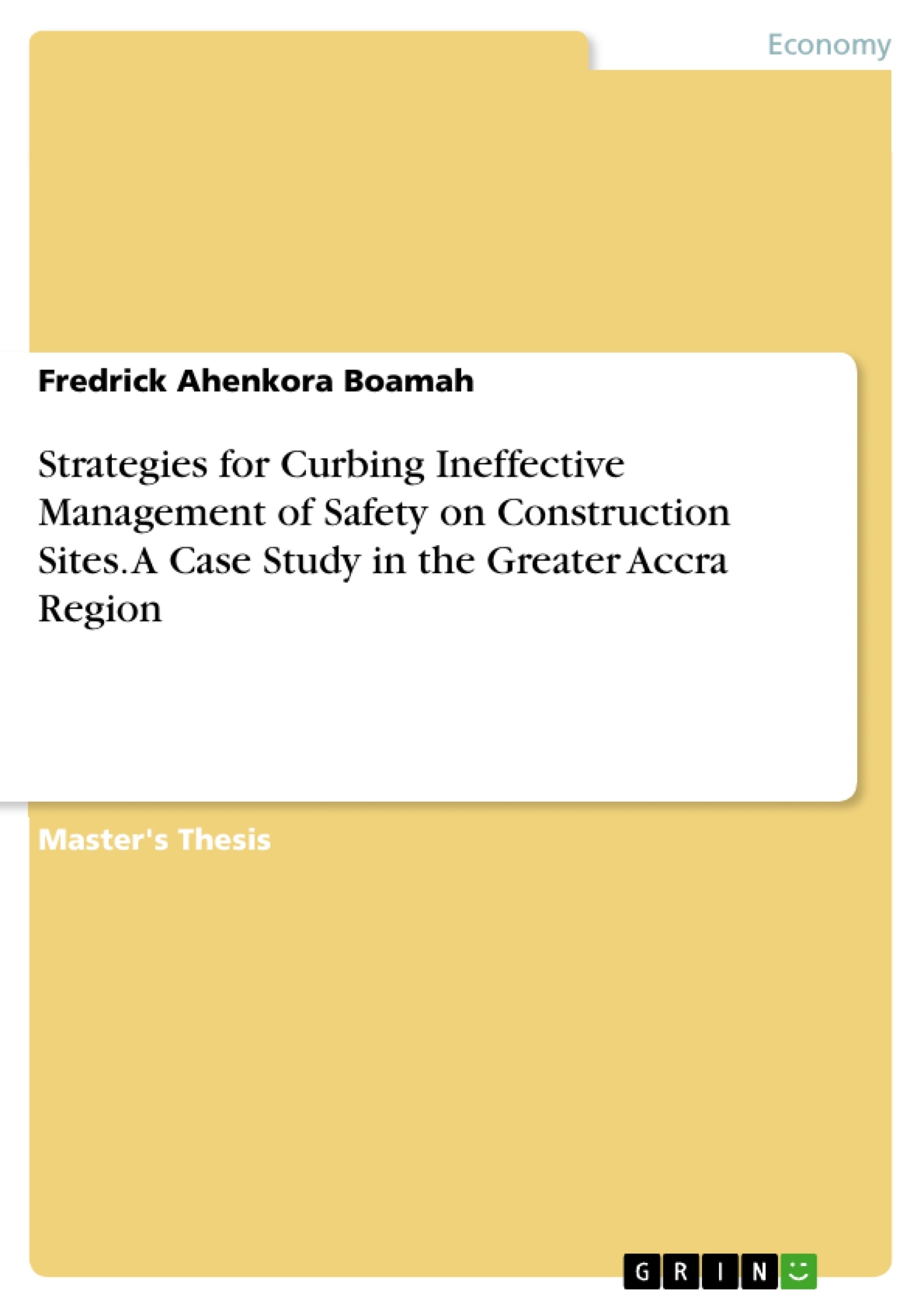To support in addressing this issue, this work was planned with the aim to recommend strategies for curbing ineffective management of safety on construction sites.
The construction industry is inherently risky, with a substantial number of accidents. Moreover, most construction firms aim at completing projects on time, especially with different projects at hand thereby neglecting the safety aspect of the workers. In most Ghanaian construction companies, adequate concentration is not allocated to the areas of health and safety and this has been a great problem over the years in which Accra Metropolis is no exception.
In order to achieve the said aim, the objectives set up include; to identify the possible causes of accident as a result of ineffective management of safety, to determine the level of accidents caused by ineffective management of safety at the construction sites and to identify strategies to curb ineffective management of safety at the construction sites. Survey questionnaires were administrated to five major construction companies in the Greater Accra Region in which the data collected was also analyzed with the Statistical Package for Social Science (SPSS) and the Relative Importance Index (RII) was also used in ranking. It was therefore revealed from the findings that poor planning at site, unsafe working conditions with others are some of the major causes of accident at site. In addition, falling victims were identified as the most serious level of accident on site. Construction companies should consider the need for special training for workers and also to create a group of internal health and safety monitory experts were some of the recommendations made.
Inhaltsverzeichnis (Table of Contents)
- CHAPTER ONE
- INTRODUCTION
- 1.1 BACKGROUND OF STUDY
- 1.2 PROBLEM STATEMENT
- 1.3 RESEARCH QUESTIONS
- 1.4 THE AIM OF THE STUDY
- 1.5 OBJECTIVES OF THE STUDY
- 1.6 JUSTIFICATION OF THE STUDY
- 1.7 THE SCOPE OF THE STUDY
- CHAPTER TWO
- LITERATURE REVIEW
- 2.1 THE CONSTRUCTION INDUSTRY
- 2.2 HEALTH AND SAFETY
- 2.3 APPLICABLE HEALTH AND SAFETY LAWS TO CONSTRUCTION
- 2.3.2 The Labour Act
- 2.3.3 The Workmen's Compensation Law in Health and Safety
- 2.4 INEFFECTIVE MANAGEMENT OF SAFETY ON THE CONSTRUCTION SITES
- 2.5 CAUSES OF POOR SAFETY IN THE CONSTRUCTION SECTOR
- 2.5.1 Reasons for the poor record
- 2.6 ACCIDENTS IN CONSTRUCTION
- 2.6.1 Causes and types of Accidents on Construction project site
- 2.7 STRATEGIES FOR IMPROVING CONSTRUCTION SAFETY
- 2.8 CAUTIONARY MEASURES
- 2.9 CONSTRUCTION PARTIES RESPONSIBILITIES IN SAFETY
- 2.9.1 Safety duties of government agencies
- 2.9.2 Safety duties of employer
- 2.9.3 Safety duties of the Contractor
- 2.9.4 Duties of employees on safety
- 2.10 COST OF ACCIDENTS IN THE CONSTRUCTION INDUSTRY
- 2.11 QUANTIFICATION OF COST
- CHAPTER THREE
- RESEARCH METHODOLOGY
- 3.1 INTRODUCTION
- 3.2 THE STUDY AREA
- 3.3 RESEARCH DESIGN
- 3.3.1 Sampling and Sampling Techniques
- 3.4 SAMPLING AND SAMPLING SIZE
- 3.5 RESEARCH INSTRUMENT
- 3.6 DATA COLLECTION
- 3.6.1 Identifying the possible causes of accidents as a result of ineffective management of safety at the construction sites
- 3.6.2 Determining the level of accidents caused by ineffective management of safety at the construction site
- 3.6.3 Identifying strategies for curbing ineffective management of safety at the construction sites
- 3.7 DATA ANALYSIS METHOD
- CHAPTER FOUR
- DATA ANALYSIS, RESULTS AND DISCUSSION
- 4.1 INTRODUCTION
- 4.2 DEMOGRAPHIC CHARACTERISTICS OF RESPONDENTS
- 4.2.1 Gender
- 4.2.2 Educational Level
- 4.2.3 Number of years of experience in constructional practices
- 4.3 CAUSES OF ACCIDENTS AT CONSTRUCTION SITES
- 4.4 LEVELS OF ACCIDENTS ON THE CONSTRUCTION SITE
- 4.5 STRATEGIES FOR CURBING INEFFECTIVE SAFETY MANAGEMENT
- CHAPTER FIVE
- SUMMARY OF FINDINGS, CONCLUSION AND RECOMMENDATIONS
- 5.1 INTRODUCTION
- 5.2 ACHIEVEMENT OF THE RESEARCH OBJECTIVES
- 5.3 SUMMARY OF FINDINGS
- 5.4 CONCLUSION
- 5.5 RECOMMENDATIONS
- 5.6 PROSPECTIVE RESEARCH
Zielsetzung und Themenschwerpunkte (Objectives and Key Themes)
This research aims to provide comprehensive strategies for addressing ineffective safety management on construction sites, particularly in the Greater Accra Region of Ghana. The study focuses on identifying the causes of accidents resulting from poor safety practices, determining the severity of these accidents, and recommending strategies to improve safety on construction sites.
- Causes of Accidents on Construction Sites
- Levels of Accidents on Construction Sites
- Strategies for Improving Safety Management
- Impact of Ineffective Safety Management on Construction Projects
- Role of Stakeholders in Enhancing Safety Practices
Zusammenfassung der Kapitel (Chapter Summaries)
Chapter 1: Introduction This chapter introduces the background of the study, highlighting the issue of ineffective safety management in the Ghanaian construction industry. It establishes the problem statement, research questions, objectives, justification, and scope of the study.
Chapter 2: Literature Review This chapter provides an extensive overview of existing literature on the construction industry, health and safety, relevant legal frameworks, and ineffective safety management practices. It explores the causes of poor safety records, different types of accidents, and strategies for improving safety in construction.
Chapter 3: Research Methodology This chapter outlines the research methodology employed in the study, including the study area, research design, sampling techniques, research instrument, data collection methods, and data analysis approaches.
Chapter 4: Data Analysis, Results and Discussion This chapter presents the analysis of the collected data, focusing on the demographic characteristics of respondents, the causes of accidents, the levels of accidents, and the strategies identified for curbing ineffective safety management.
Schlüsselwörter (Keywords)
This study focuses on the intersection of safety management, construction accidents, and risk mitigation in the Ghanaian construction industry. It explores the impact of ineffective safety practices, investigates the causes and severity of accidents, and provides evidence-based recommendations for enhancing safety on construction sites. Key themes include: Construction Safety, Accident Prevention, Risk Assessment, Safety Training, Legal Compliance, and Stakeholder Engagement.
- Citar trabajo
- Fredrick Ahenkora Boamah (Autor), 2016, Strategies for Curbing Ineffective Management of Safety on Construction Sites. A Case Study in the Greater Accra Region, Múnich, GRIN Verlag, https://www.grin.com/document/355093



